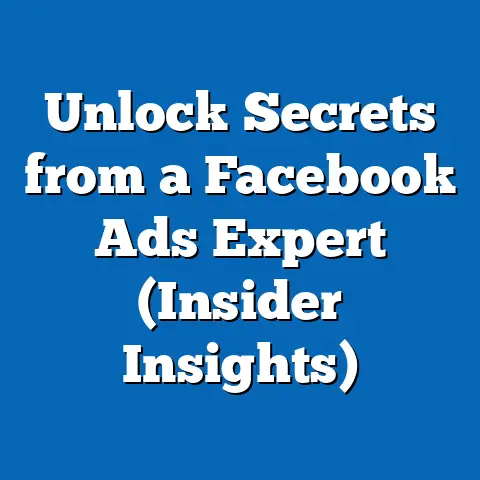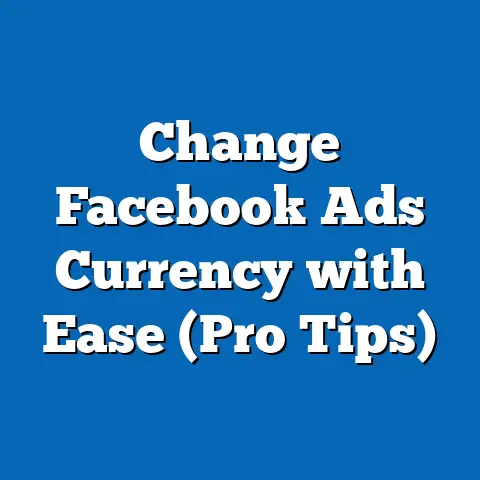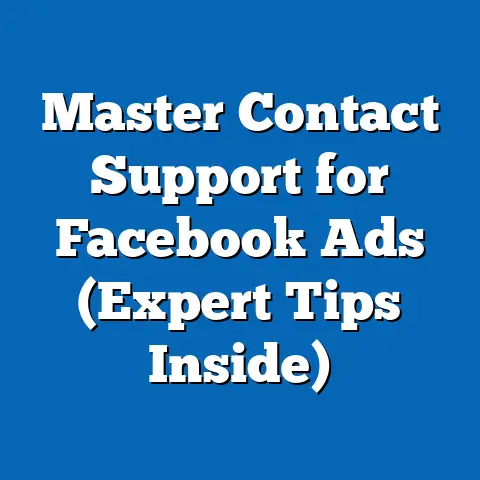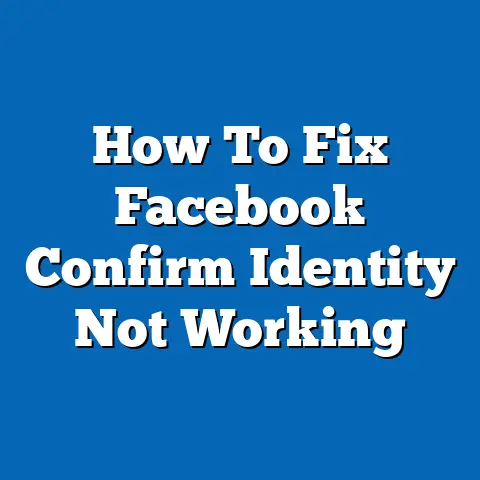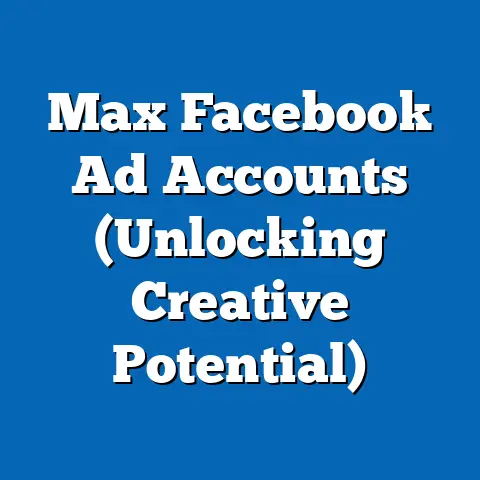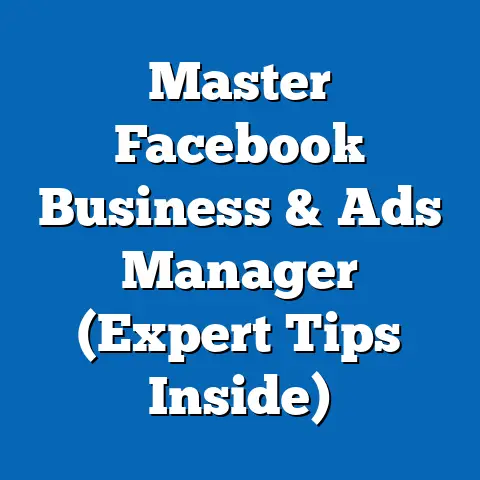Maximize Facebook Ads Reach with CTR Secrets (Expert Insights)
Facebook advertising. It’s a beast, isn’t it? I remember when I first started, I felt like I was throwing money into a black hole, hoping something would stick. What I quickly learned, and what I want to share with you today, is that success on Facebook boils down to understanding and mastering a few key metrics, and Click-Through Rate (CTR) is right at the top of that list.
Facebook Ads have become an indispensable tool in the digital marketing landscape. What I love about them is their versatility. Whether you’re a small local business trying to reach customers in your neighborhood or a large corporation launching a nationwide campaign, Facebook Ads can be tailored to fit your specific needs and budget. This platform allows you to target a diverse audience with precision, ensuring that your message reaches the right people at the right time.
But simply creating an ad isn’t enough. To truly maximize your reach and achieve your marketing goals, you need to understand and optimize your Click-Through Rate (CTR). A high CTR indicates that your ads are resonating with your target audience, leading to better ad placements, lower costs, and ultimately, a higher return on investment (ROI).
In this article, I’m going to pull back the curtain and share some expert insights and practical strategies that I’ve learned over the years to help you unlock the secrets of improving CTR for your Facebook Ads. Let’s dive in!
Understanding CTR in the Context of Facebook Ads
Let’s start with the basics.
What is Click-Through Rate (CTR)?
Click-Through Rate (CTR) is a fundamental metric in online advertising that measures the percentage of people who click on your ad after seeing it. It’s a simple but powerful indicator of how relevant and engaging your ad is to your target audience.
How is CTR Calculated on Facebook?
On Facebook, CTR is calculated by dividing the number of clicks your ad receives by the number of times your ad is shown (impressions), and then multiplying by 100 to express it as a percentage.
Formula: CTR = (Number of Clicks / Number of Impressions) * 100
For example, if your ad receives 100 clicks after being shown 10,000 times, your CTR would be 1%.
Why Does CTR Matter for Facebook Advertisers?
CTR is more than just a number; it’s a critical indicator of your ad’s performance and relevance. A higher CTR tells Facebook that your ad is engaging and valuable to users. This, in turn, can lead to several benefits:
- Improved Ad Placement: Facebook’s algorithm favors ads with higher CTRs, giving them better placement in users’ news feeds and other ad spaces.
- Lower Costs: Ads with higher CTRs often have lower costs per click (CPC) and cost per thousand impressions (CPM). This means you can reach more people for the same budget.
- Increased Conversions: A higher CTR means more people are clicking on your ad and visiting your landing page. This increases the likelihood of conversions, whether it’s making a purchase, signing up for a newsletter, or filling out a form.
I’ve personally seen campaigns where a small increase in CTR led to a significant decrease in cost per conversion, ultimately boosting the overall ROI.
CTR and Ad Reach: A Symbiotic Relationship
The relationship between CTR and ad reach is symbiotic. A higher CTR leads to better ad placements, which in turn increases your ad’s reach. When Facebook sees that your ad is generating clicks and engagement, it rewards you by showing it to more people.
Think of it like this: Facebook wants to provide its users with a positive experience. If your ad is engaging and relevant, users are more likely to click on it and interact with your brand. This signals to Facebook that your ad is valuable, and it will show it to more users who are likely to be interested.
The Importance of Ad Relevance
Ad relevance is a key factor that affects CTR on Facebook. Facebook uses a metric called “Ad Relevance Diagnostics” to assess how relevant your ad is to your target audience. This metric takes into account factors such as:
- Quality Ranking: How your ad is perceived compared to ads competing for the same audience.
- Engagement Rate Ranking: How your ad is performing in terms of engagement compared to other ads.
- Conversion Rate Ranking: How your ad is driving conversions compared to other ads.
If your ad has a high relevance score, it’s more likely to be shown to your target audience, and it’s more likely to generate clicks.
Takeaway: Understanding CTR and its relationship with ad reach and ad relevance is crucial for maximizing the effectiveness of your Facebook Ads. By focusing on improving your CTR, you can increase your ad’s reach, lower your costs, and drive more conversions.
Crafting Compelling Ad Copy
Now that we understand the importance of CTR, let’s talk about how to improve it. One of the most important factors is your ad copy.
The Power of Words: Clear, Concise, and Engaging Copy
Your ad copy is your first opportunity to grab the attention of your target audience. It needs to be clear, concise, and engaging. Here’s what I’ve learned:
- Clarity is Key: Make sure your message is easy to understand. Avoid jargon and complicated language. Tell your audience exactly what you’re offering and what they can expect if they click on your ad.
- Conciseness Matters: People scroll through their news feeds quickly. Get to the point and highlight the most important information. Use short sentences and paragraphs to make your ad copy easy to read.
- Engagement is Essential: Use language that resonates with your target audience. Appeal to their emotions, address their pain points, and offer solutions to their problems.
Headlines That Grab Attention: Expert Insights
Your headline is the most important part of your ad copy. It’s the first thing people see, and it determines whether or not they’ll continue reading. Here are some tips for writing headlines that grab attention:
- Use Numbers and Lists: Headlines with numbers and lists tend to perform well because they’re easy to scan and promise valuable information. For example, “5 Ways to Improve Your Facebook Ad CTR” or “The Ultimate Guide to Facebook Advertising.”
- Ask a Question: Questions can pique curiosity and encourage people to click on your ad to find the answer. For example, “Are You Making These Common Facebook Ad Mistakes?” or “Want to Double Your Sales with Facebook Ads?”
- Create Urgency: Headlines that create a sense of urgency can motivate people to click on your ad immediately. For example, “Limited Time Offer: 50% Off All Products” or “Don’t Miss Out: Last Day to Save on Our Best-Selling Course.”
- Highlight Benefits: Focus on the benefits of your product or service, rather than just the features. For example, “Get More Leads with Our Proven Facebook Ad Strategies” or “Transform Your Business with Our Expert Marketing Services.”
I’ve found that testing different headlines is crucial. A/B testing allows you to see which headlines resonate best with your target audience and generate the highest CTR.
Value Propositions That Resonate
Your value proposition is the unique benefit that your product or service offers to your target audience. It’s what sets you apart from your competitors and makes people want to choose you. Here’s how to incorporate a strong value proposition into your ad copy:
- Identify Your Target Audience’s Pain Points: What problems are they facing? What challenges are they trying to overcome?
- Offer a Solution: Explain how your product or service can solve their problems and make their lives easier.
- Highlight the Benefits: Focus on the tangible benefits that your target audience will receive. How will your product or service improve their lives?
- Be Specific: Avoid vague or generic language. Use concrete examples and data to support your claims.
For example, instead of saying “Our software is easy to use,” say “Our software is so easy to use that you can create professional-looking marketing campaigns in just minutes, even if you have no prior experience.”
The Significance of a Strong Call-to-Action (CTA)
Your call-to-action (CTA) is the final nudge that encourages people to click on your ad. It needs to be clear, concise, and compelling. Here are some examples of effective CTAs that drive click-throughs:
- Shop Now: Use this CTA when you want people to make a purchase.
- Learn More: Use this CTA when you want people to visit your website and learn more about your product or service.
- Sign Up: Use this CTA when you want people to subscribe to your newsletter or create an account.
- Get Started: Use this CTA when you want people to try your product or service for free.
- Download Now: Use this CTA when you want people to download a free resource, such as an ebook or whitepaper.
Make sure your CTA stands out visually. Use a button with a contrasting color and a clear, easy-to-read font.
Takeaway: Crafting compelling ad copy is essential for improving your Facebook Ad CTR. By writing clear, concise, and engaging copy with attention-grabbing headlines, strong value propositions, and effective CTAs, you can encourage more people to click on your ads and visit your website.
Visual Elements that Boost CTR
While words are important, let’s be honest, we live in a visual world. The right image or video can stop someone mid-scroll and entice them to learn more.
The Impact of Visuals on Facebook Ads
Visuals play a crucial role in the success of your Facebook Ads. They’re the first thing people see, and they can make or break your ad’s ability to grab attention and generate clicks.
Think of your visuals as the hook that reels in your target audience. They need to be eye-catching, relevant, and engaging. Here’s why visuals are so important:
- They Grab Attention: In a sea of text and updates, a compelling visual can stand out and capture the attention of your target audience.
- They Communicate Quickly: Visuals can communicate complex ideas and emotions much faster than text.
- They Create Emotion: Visuals can evoke emotions that resonate with your target audience, making them more likely to click on your ad.
- They Reinforce Your Message: Visuals can reinforce your message and help people remember your brand.
Choosing the Right Visual: Images, Videos, or Carousels?
Facebook offers a variety of ad formats, each with its own strengths and weaknesses. Here’s a breakdown of the most popular visual ad formats:
- Single Image Ads: These ads feature a single image and are ideal for showcasing a product, service, or brand. They’re simple, effective, and easy to create.
- Video Ads: These ads feature a video and are ideal for telling a story, demonstrating a product, or showcasing your brand’s personality. They’re more engaging than image ads but require more time and resources to create.
- Carousel Ads: These ads feature multiple images or videos that users can swipe through. They’re ideal for showcasing multiple products, telling a story in sequential order, or highlighting different features of a single product.
So, which ad format should you choose? It depends on your goals, your budget, and your target audience. I generally recommend testing different ad formats to see which ones perform best for your specific campaign.
Best Practices for Creating Eye-Catching Visuals
Creating effective visuals is an art and a science. Here are some best practices to keep in mind:
- Use High-Quality Images and Videos: Make sure your visuals are clear, sharp, and well-lit. Avoid blurry or pixelated images.
- Choose Relevant Visuals: Your visuals should be relevant to your ad copy and your target audience.
- Use Colors That Pop: Use colors that stand out and grab attention. Consider using contrasting colors to make your visuals more eye-catching.
- Incorporate Text: Add text to your visuals to reinforce your message and highlight key benefits.
- Keep it Simple: Avoid cluttering your visuals with too many elements. Focus on one or two key messages.
- Test Different Visuals: A/B test different visuals to see which ones perform best with your target audience.
Color Psychology and Design Principles
Understanding color psychology and design principles can help you create visuals that resonate with your target audience.
- Color Psychology: Different colors evoke different emotions. For example, blue is often associated with trust and reliability, while red is associated with excitement and energy.
- Design Principles: Design principles such as balance, contrast, and hierarchy can help you create visuals that are visually appealing and easy to understand.
I’ve found that using color psychology and design principles can significantly improve the performance of my Facebook Ads.
The Power of A/B Testing Visuals
A/B testing is a crucial part of optimizing your Facebook Ads. It allows you to test different visuals and see which ones perform best with your target audience.
When A/B testing visuals, focus on testing one element at a time. For example, you could test different images, different colors, or different text overlays. This will help you isolate the factors that are driving performance and make informed decisions about your ad creative.
Takeaway: Visuals are a critical component of successful Facebook Ads. By choosing the right ad format, creating eye-catching visuals, and understanding color psychology and design principles, you can significantly improve your ad CTR and drive more conversions.
Targeting the Right Audience
You could have the most stunning visual and the most compelling copy, but if you’re showing it to the wrong people, it’s all for naught. Audience targeting is where Facebook Ads truly shine.
Why Audience Targeting Matters
Audience targeting is the process of selecting the specific group of people who will see your ads. It’s a crucial part of maximizing your ad reach and CTR.
Think of it like this: You wouldn’t try to sell snow shovels in Florida, would you? Similarly, you shouldn’t show your ads to people who aren’t interested in your product or service.
By targeting the right audience, you can ensure that your ads are seen by people who are most likely to be interested in your offer. This leads to higher CTRs, lower costs, and ultimately, more conversions.
Facebook’s Audience Targeting Options
Facebook offers a wide range of audience targeting options, allowing you to reach your ideal customers with precision. Here are some of the most popular targeting options:
- Demographics: Target people based on their age, gender, education, relationship status, and other demographic information.
- Interests: Target people based on their interests, hobbies, and activities. Facebook gathers this information from the pages people like, the groups they join, and the content they interact with.
- Behaviors: Target people based on their online behavior, such as their purchase history, their travel habits, and their device usage.
- Location: Target people based on their location, such as their city, state, or country.
- Connections: Target people who are connected to your Facebook page, event, or app.
Creating Custom Audiences
Custom Audiences allow you to target people who have already interacted with your business, either online or offline. Here are some examples of Custom Audiences you can create:
- Website Visitors: Target people who have visited your website.
- Email List Subscribers: Target people who are on your email list.
- App Users: Target people who have downloaded your app.
- Customer List: Target people who are on your customer list.
- Offline Activity: Target people who have interacted with your business offline, such as by making a purchase in your store.
Custom Audiences are a powerful way to re-engage existing customers and drive repeat business.
Leveraging Lookalike Audiences
Lookalike Audiences allow you to target people who are similar to your existing customers. Facebook uses its algorithm to identify the characteristics of your best customers and then finds other people who share those characteristics.
Lookalike Audiences are a great way to expand your reach and find new customers who are likely to be interested in your product or service.
Refining Audience Targeting Based on Analytics
Audience targeting is not a set-it-and-forget-it process. You need to continuously monitor your ad performance and refine your audience targeting based on the data you collect.
Facebook Ads Manager provides a wealth of data about your audience, including their demographics, interests, and behaviors. Use this data to identify the segments of your audience that are performing best and focus your targeting efforts on those segments.
Takeaway: Audience targeting is a critical component of successful Facebook Ads. By understanding Facebook’s audience targeting options, creating Custom Audiences and Lookalike Audiences, and refining your targeting based on analytics, you can maximize your ad reach and CTR.
Leveraging Facebook Ad Formats
Facebook is a constantly evolving platform, and the ad formats are no exception. Staying on top of the latest options can give you a real edge.
Understanding the Variety of Ad Formats
Facebook offers a variety of ad formats, each with its own unique features and benefits. Choosing the right ad format can significantly impact your ad CTR and overall campaign performance.
Here are some of the most popular ad formats available on Facebook:
- Single Image Ads: These ads feature a single image and are ideal for showcasing a product, service, or brand.
- Video Ads: These ads feature a video and are ideal for telling a story, demonstrating a product, or showcasing your brand’s personality.
- Carousel Ads: These ads feature multiple images or videos that users can swipe through. They’re ideal for showcasing multiple products, telling a story in sequential order, or highlighting different features of a single product.
- Collection Ads: These ads feature a cover image or video followed by a collection of products. They’re ideal for showcasing your product catalog and driving sales.
- Instant Experience Ads: These ads are full-screen, mobile-optimized experiences that load instantly when someone clicks on your ad. They’re ideal for telling a story, showcasing your brand, or driving conversions.
- Lead Ads: These ads allow you to collect leads directly from Facebook without sending people to your website. They’re ideal for generating leads for your sales team or building your email list.
Choosing the Right Ad Format for Your Goals
The best ad format for your campaign depends on your goals, your budget, and your target audience. Here are some general guidelines:
- If you want to showcase a single product or service: Use a single image ad or a video ad.
- If you want to showcase multiple products or tell a story: Use a carousel ad or a collection ad.
- If you want to create an immersive brand experience: Use an Instant Experience ad.
- If you want to generate leads: Use a lead ad.
The Power of Dynamic Ads
Dynamic Ads are a powerful way to automatically tailor your ad content to user preferences. They use data from your product catalog to show people ads for products they’ve already viewed on your website or in your app.
Dynamic Ads are highly effective because they’re personalized and relevant. They show people ads for products they’re already interested in, which increases the likelihood of them clicking on the ad and making a purchase.
Facebook Stories and Messenger Ads
Facebook Stories and Messenger ads are relatively new ad formats that offer unique opportunities to engage with your target audience.
- Facebook Stories Ads: These ads appear between users’ Stories and are ideal for capturing attention and driving brand awareness.
- Messenger Ads: These ads appear in users’ Messenger inboxes and are ideal for starting conversations and driving leads.
Takeaway: Leveraging the right Facebook Ad format can significantly improve your ad CTR and overall campaign performance. By understanding the different ad formats available and choosing the ones that are best suited for your goals, you can maximize your ad reach and drive more conversions.
Conclusion
We’ve covered a lot of ground, haven’t we? From understanding the importance of CTR to crafting compelling ad copy, choosing the right visuals, targeting the right audience, and leveraging different ad formats, you now have a comprehensive toolkit for maximizing your Facebook Ads reach.
Remember, the key to success with Facebook Ads is to continuously test and optimize your campaigns. Stay updated on industry trends, experiment with different strategies, and track your results. By doing so, you can unlock the full potential of Facebook Ads and achieve your marketing goals.
I’ve shared with you some of the strategies I’ve used over the years to achieve significant improvements in my Facebook Ad campaigns. It’s not always easy, but with the right knowledge and a willingness to experiment, you can achieve great results.
Next Steps
- Review Your Existing Campaigns: Take a look at your current Facebook Ad campaigns and identify areas where you can improve your CTR.
- Implement the Strategies: Start implementing the strategies discussed in this article, such as crafting compelling ad copy, choosing the right visuals, and refining your audience targeting.
- Track Your Results: Monitor your ad performance closely and track your CTR, CPC, and conversion rate.
- Continuously Optimize: Continuously optimize your campaigns based on the data you collect.
Call to Action: I’d love to hear about your experiences with Facebook Ads. What strategies have worked best for you? Do you have any additional tips for improving CTR? Share your thoughts in the comments section below. And don’t forget to subscribe for more expert insights on digital marketing strategies! Let’s learn and grow together.

